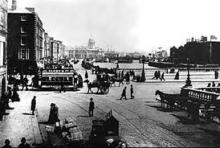American cities didn’t always resemble the kind of places that we know and recognize today. Government and police forces weren’t organized, but instead operated as volunteer forces. Plumbing and sanitation concerns killed hundreds of thousands of people. Roads weren’t designed and neither was housing organized. We 21st century city dwellers wouldn’t have known what hit us, that’s for sure.
In early American cities, immigrant groups from Western Europe made up the bulk of the population. Cultural assimilation of white, Western immigrants was quick and absolute—it wasn’t long until German culture in places like Chicago was American culture. Class and wealth distinction weren’t set yet in early American cities—in places like taverns, lower and upper class mingled together drinking and cavorting.
By 1890, over 80% of Chicagoans were either born outside of the country themselves or had parents who were. Germans and the English knew how industrialization worked so they worked to industrialize many American cities. Cities started being structured in this way—factories employed mostly immigrant labor and these immigrants lived in rings and towns around the factories. Lumber, meatpacking, mail order catalogs and transportation were the biggest industries in early industrializing American cities.
Still, it wasn’t all fun and games in America for the new immigrant populations. Cholera epidemics in the early 19th century were blamed on the uncleanliness of the lower immigrant classes. People thought that disease outbreaks came from the crowded quarters that they lived in and were spread by vapors in the air.
Some of these ideas were half-truths—sometimes the conditions of American lands were so foreign to immigrants, they couldn’t adjust properly and fell ill. Tenement housing in America’s largest cities were cramped and unclean, but poor immigrants had few other options. There weren’t fresh foods in many cities and without health regulations, wheeler-dealers made people even sicker with their sales of unsafe foodstuffs.
Unfortunately, critics at the time started associating this kind of physical illness with moral degradation. This idea started the orphan train, sending orphaned or poor immigrant children out of America’s largest cities into the countryside.
There were also a number of anti-immigration movements throughout the country. The Know Nothing party despised Irish Catholic and encouraged businesses to bar them from entering. The Nativist movement and the resurgence of the Ku Klux Klan rallied to have immigration stopped altogether. After the Haymarket bombing in Chicago, perpetrated by seven German anarchists, anti-German sentiment ran high.
In the second waves of immigration, central and eastern Europeans started coming to the United States. Unlike their fairer skinned European counterparts, these darker skinned immigrants stuck out amongst city populations as foreigner. Because of this, newer immigrant populations resisted the assimilationist patterns of earlier Europeans. They kept their own schools and churches and many, particularly Italian immigrants, only planned on staying in American for short periods. These sentiments drove further divisions between the lower and upper classes. Upper classes watched football and other sports while lower classes went to movie theaters and amusement parks.
